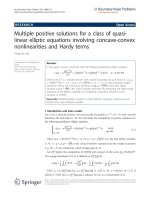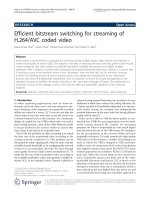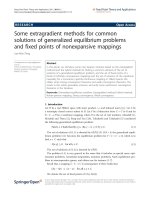Báo cáo hóa học: "MULTIPLE NONNEGATIVE SOLUTIONS FOR BVPs OF FOURTH-ORDER DIFFERENCE EQUATIONS" pptx
Bạn đang xem bản rút gọn của tài liệu. Xem và tải ngay bản đầy đủ của tài liệu tại đây (481.31 KB, 7 trang )
MULTIPLE NONNEGATIVE SOLUTIONS FOR BVPs OF
FOURTH-ORDER DIFFERENCE EQUATIONS
JIAN-PING SUN
Received 31 March 2006; Revised 5 September 2006; Accepted 18 September 2006
First, existence criteria for at least three nonnegative solutions to the following boundary
value problem of fourth-order difference equation Δ
4
x(t − 2) = a(t) f (x(t)), t ∈ [2,T],
x(0)
= x(T +2)=0, Δ
2
x(0) = Δ
2
x(T)=0 are established by using the well-known Leggett-
Williams fixed point theorem, and then, for arbitrary positive integer m, existence results
for at least 2m
− 1 nonnegative solutions are obtained.
Copyright © 2006 Jian-Ping Sun. This is an open access article distributed under the Cre-
ative Commons Attribution License, which permits unrestricted use, distr ibution, and
reproduction in any medium, provided the original work is properly cited.
1. Introduction
Recently,boundaryvalueproblems(BVPs)ofdifference equations have received consid-
erable attention from many authors, see [1–5, 7–9, 12–19] and the references therein. In
particular, Zhang et al. [19] established the existence of positive solution to the fourth-
order BVP
Δ
4
x(t − 2) = λa(t) f
t,x(t)
, t ∈ N,2≤ t ≤ T,
x(0)
= x(T +2)= 0,
Δ
2
x(0) = Δ
2
x(T) = 0
(1.1)
by using the method of upper and lower solutions, and then Sun [15] obtained the exis-
tence of one positive solution for the following four th-order BVP:
Δ
4
x(t − 2) = a(t) f
x(t)
, t ∈ [2,T],
x(0)
= x(T +2)= 0,
Δ
2
x(0) = Δ
2
x(T) = 0
(1.2)
Hindawi Publishing Corporation
Advances in Difference Equations
Volume 2006, Article ID 89585, Pages 1–7
DOI 10.1155/ADE/2006/89585
2 Solutions to BVPs of fourth-order difference equations
under the assumption that f is either superlinear or sublinear, where T>2isafixed
positive integer, Δ
m
denotes the mth forward difference operator with stepsize 1, and
[a,b]
={a,a +1, ,b − 1,b}⊂Z the set of all integers. Our main tool was the Guo-
Krasnosel’skii fixed point theorem in cone [6, 10].
In this paper we will continue to consider the BVP (1.2). First, existence criteria for
at least three nonnegative solutions to the BVP (1.2) are established by using the well-
known Leggett-Williams fixed point theorem [11], and then, for arbitrary positive in-
teger m, existence results for at least 2m
− 1 nonnegative solutions to the BVP (1.2)are
obtained.
Throughout this paper, we assume that the following two conditions are satisfied.
(C1) f :[0,
∞) → [0,∞)iscontinuous.
(C2) a :[2,T]
→ [0,∞) is not identical zero.
In order to obtain our main results, we need the following concepts and Leggett-
Williams fixed point theorem.
Let E be a real Banach space with cone P.Amapα : P
→ [0,+∞)issaidtobeanon-
negative continuous concave functional on P if α is continuous and
α
tx +(1− t)y
≥
tα(x)+(1− t)α(y) (1.3)
for all x, y
∈ P and t ∈ [0,1]. Let a, b be two numbers such that 0 <a<band let α be a
nonnegative continuous concave functional on P. We define the following convex sets:
P
a
=
x ∈ P : x <a
,
P(α,a,b)
=
x ∈ P : a ≤ α(x), x≤b
.
(1.4)
Theorem 1.1 (Leggett-Williams fixed point theorem). Let A :
P
c
→ P
c
be completely con-
tinuous and let α be a nonnegative continuous concave functional on P such that α(x)
≤x
for all x ∈ P
c
.Supposethereexist0 <d<a<b≤ c such that
(i)
{x ∈ P(α,a,b):α(x) >a} = φ and α(Ax) >afor x ∈ P(α,a,b);
(ii)
Ax <dfor x≤d;
(iii) α(Ax) >afor x
∈ P(α,a,c) with Ax >b.
Then A has at least three fixed points x
1
, x
2
, x
3
in P
c
satisfying
x
1
<d, a<α
x
2
,
x
3
>d, α
x
3
<a. (1.5)
2. Main results
For convenience, we denote
G
1
(t,s) =
1
T
⎧
⎨
⎩
(t − 1)(T +1− s), 1 ≤ t ≤ s ≤ T,
(s
− 1)(T +1− t), 2 ≤ s ≤ t ≤ T +1,
G
2
(t,s) =
1
T +2
⎧
⎨
⎩
t(T +2− s), 0 ≤ t ≤ s ≤ T +1,
s(T +2
− t), 1 ≤ s ≤ t ≤ T +2,
Jian-Ping Sun 3
D
= max
t∈[0,T+2]
T+1
s=1
G
2
(t,s)
T
v=2
G
1
(s,v)a(v),
C
= min
t∈[2,T]
T+1
s=1
G
2
(t,s)
T
v=2
G
1
(s,v)a(v).
(2.1)
It is easily seen from the expression of G
2
(t,s)that
G
2
(t,s) ≤ G
2
(s,s), (t,s) ∈ [0,T +2]× [1,T +1],
G
2
(t,s) ≥
1
T +1
G
2
(s,s), (t,s) ∈ [1,T +1]× [1,T +1].
(2.2)
Our main result is the fol l owing theorem.
Theorem 2.1. Assume that there exist numbers d, a,andc with 0 <d<a<(T +1)a<c
such that
f (x) <
d
D
, x
∈ [0,d], (2.3)
f (x) >
a
C
, x
∈
a,(T +1)a
, (2.4)
f (x) <
c
D
, x
∈ [0,c]. (2.5)
Then the BVP (1.2) has at least three nonnegative solutions.
Proof. Let the Banach space E
={x :[0,T +2]→ R} be equipped with the norm
x= max
t∈[0,T+2]
x(t)
. (2.6)
We defi ne
P
=
x ∈ E : x(t) ≥ 0, t ∈ [0,T +2]
, (2.7)
then it is obvious that P is a cone in E.
For x
∈ P,wedefine
α(x)
= min
t∈[2,T]
x(t),
(Ax)(t)
=
T+1
s=1
G
2
(t,s)
T
v=2
G
1
(s,v)a(v) f
x(v)
, t ∈ [0,T +2].
(2.8)
It is easy to check that α is a nonnegative continuous concave functional on P with α(x)
≤
x for x ∈ P and that A : P → P is completely continuous and fixed points of A are
solutions of the BVP (1.2).
We first assert that if there exists a positive number r such that f (x) <r/Dfor x
∈ [0,r],
then A :
P
r
→ P
r
.
4 Solutions to BVPs of fourth-order difference equations
Indeed, if x
∈ P
r
,thenfort ∈ [0,T +2],
(Ax)(t)
=
T+1
s=1
G
2
(t,s)
T
v=2
G
1
(s,v)a(v) f
x(v)
<
r
D
T+1
s=1
G
2
(t,s)
T
v=2
G
1
(s,v)a(v)
≤
r
D
max
t∈[0,T+2]
T+1
s=1
G
2
(t,s)
T
v=2
G
1
(s,v)a(v) = r.
(2.9)
Thus,
Ax <r, that is, Ax ∈ P
r
.
Hence, we have shown that if (2.3)and(2.5) hold, then A maps
P
d
into P
d
and P
c
into P
c
.
Next, we assert that
{x ∈ P(α,a,(T +1)a):α(x) >a} = φ and α(Ax) >afor all x ∈
P(α,a,(T +1)a).
In fact, the constant function
(T +2)a
2
∈
x ∈ P
α,a,(T +1)a
: α(x) >a
. (2.10)
Moreover , for x
∈ P(α,a,(T +1)a), we have
(T +1)a
≥x≥x(t) ≥ min
t∈[2,T]
x(t) = α(x) ≥ a (2.11)
for all t
∈ [2,T]. Thus, in view of (2.4), we see that
α(Ax)
= min
t∈[2,T]
T+1
s=1
G
2
(t,s)
T
v=2
G
1
(s,v)a(v) f
x(v)
>
a
C
min
t∈[2,T]
T+1
s=1
G
2
(t,s)
T
v=2
G
1
(s,v)a(v) = a
(2.12)
as required.
Finally, we assert that if x
∈ P(α,a,c)andAx > (T +1)a,thenα(Ax) >a.
To see this, suppose x
∈ P(α,a,c)andAx > (T +1)a, then i n view of (2.2), we have
α(Ax)
= min
t∈[2,T]
T+1
s=1
G
2
(t,s)
T
v=2
G
1
(s,v)a(v) f
x(v)
≥
1
T +1
T+1
s=1
G
2
(s,s)
T
v=2
G
1
(s,v)a(v) f
x(v)
≥
1
T +1
T+1
s=1
G
2
(t,s)
T
v=2
G
1
(s,v)a(v) f
x(v)
(2.13)
Jian-Ping Sun 5
for t
∈ [0,T +2].Thus
α(Ax)
≥
1
T +1
max
t∈[0,T+2]
T+1
s=1
G
2
(t,s)
T
v=2
G
1
(s,v)a(v) f
x(v)
=
1
T +1
Ax >
1
T +1
(T +1)a
= a.
(2.14)
To sum up, all the hypotheses of the Leggett-Williams theorem are satisfied. Hence
A has at least three fixed points, that is, the BVP (1.2) has at least three nonnegative
solutions u, v,andw such that
u <d, a< min
t∈[2,T]
v(t), w >d,
min
t∈[2,T]
w(t) <a.
(2.15)
The proof is complete.
Corollary 2.2. Let m be an arbitrar y positive integer. Assume that there exist numbers d
j
(1 ≤ j ≤ m) and a
h
(1 ≤ h ≤ m − 1) with 0 <d
1
<a
1
< (T +1)a
1
<d
2
<a
2
< (T +1)a
2
<
···<d
m−1
<a
m−1
< (T +1)a
m−1
<d
m
such that
f (x) <
d
j
D
, x
∈
0,d
j
,1≤ j ≤ m, (2.16)
f (x) >
a
h
C
, x
∈
a
h
,(T +1)a
h
,1≤ h ≤ m − 1. (2.17)
Then, the BVP (1.2) has at least 2m
− 1 nonnegative solutions in P
d
m
.
Proof. We prove this conclusion by induction.
First, for m
= 1, we know from (2.16)thatA : P
d
1
→ P
d
1
⊂ P
d
1
, then, it follows from
Schauder fixed point theorem that the BVP (1.2) has at least one nonnegative solution in
P
d
1
.
Next, we assume that this conclusion holds for m
= k. In order to prove that this con-
clusion also holds for m
= k + 1, we suppose that there exist numbers d
j
(1 ≤ j ≤ k +1)
and a
h
(1 ≤ h ≤ k)with0<d
1
<a
1
< (T +1)a
1
<d
2
<a
2
< (T +1)a
2
< ··· <d
k
<a
k
<
(T +1)a
k
<d
k+1
such that
f (x) <
d
j
D
, x
∈
0,d
j
,1≤ j ≤ k +1,
f (x) >
a
h
C
, x
∈
a
h
,(T +1)a
h
,1≤ h ≤ k.
(2.18)
By the assumption, (2.18), we know that the BVP (1.2) has at least 2k
− 1 nonnegative
solutions x
i
(i = 1,2, ,2k − 1) in P
d
k
. At the same time, it follows from Theorem 2.1
and (2.18) that the BVP (1.2) has at least three nonnegative solutions u, v,andw in
P
d
k+1
6 Solutions to BVPs of fourth-order difference equations
such that
u <d
k
, a
k
< min
t∈[2,T]
v(t), w >d
k
,
min
t∈[2,T]
w(t) <a
k
.
(2.19)
Obviously, v and w are different from x
i
(i = 1,2, ,2k − 1). Therefore, the BVP (1.2)has
at least 2k + 1 nonnegative solutions in
P
d
k+1
, which shows that this conclusion also holds
for m
= k +1.Theproofiscomplete.
Acknowledgment
This work was supported by the NSF of Gansu Province of China (3ZS042-B25-020).
References
[1] R.P.Agarwal,Difference Equations and Inequalities, 2nd ed., Monographs and Textbooks in Pure
and Applied Mathematics, vol. 228, Marcel Dekker, New York, 2000.
[2] R.P.Agarwal,M.Bohner,andP.J.Y.Wong,Eigenvalues and eigenfunctions of discrete conjugate
boundary value problems, Computers & Mathematics with Applications 38 (1999), no. 3-4, 159–
183.
[3] R. P. Agarwal and J. Henderson, Positive solutions and nonlinear eigenvalue problems for third-
order difference equations, Computers & Mathematics with Applications 36 (1998), no. 10–12,
347–355.
[4] R. P. Agarwal and P. J. Y. Wong, Advanced Topics in Difference Equations, Mathematics and Its
Applications, vol. 404, Kluwer Academic, Dordrecht, 1997.
[5] R. P. Agarwal and F H. Wong, Existence of positive solutions for higher order difference equations,
Applied Mathematics Letters 10 (1997), no. 5, 67–74.
[6] D. J. Guo and V. Lakshmikantham, Nonlinear Problems in Abstract Cones, Notes and Reports in
Mathematics in Science and Engineering, vol. 5, Academic Press, Massachusetts, 1988.
[7] P. Hartman, Difference equations: disconjugacy, principal solutions, Green’s functions, complete
monotonicity, Transactions of the American Mathematical Society 246 (1978), 1–30.
[8] J. Henderson, Positive solutions for nonlinear difference equations, Nonlinear Studies 4 (1997),
no. 1, 29–36.
[9] J.HendersonandP.J.Y.Wong,On multiple solutions of a system of m discrete boundary value
problems,Zeitschriftf
¨
ur Angewandte Mathematik und Mechanik 81 (2001), no. 4, 273–279.
[10] M. A. Krasnosel’ski
˘
ı, Positive Solutions of Operator Equations, P. Noordhoff, Groningen, 1964.
[11] R. W. Leggett and L. R. Williams, Multiple positive fixed points of nonlinear operators on ordered
Banach spaces, Indiana University Mathematics Journal 28 (1979), no. 4, 673–688.
[12] R J. Liang, Y H. Zhao, and J P. Sun, A new theorem of existence to fourth-order boundary value
problem, International Journal of Differential Equations and Applications 7 (2003), no. 3, 257–
262.
[13] F. Merdivenci, Green’s matrices and positive solutions of a discrete boundary value problem,
Panamerican Mathematical Journal 5 (1995), no. 1, 25–42.
[14]
, Two positive solutions of a boundary value problem for difference equations,Journalof
Difference Equations and Applications 1 (1995), no. 3, 263–270.
[15] J P. Sun, Positive solution for BVPs of fourth order difference equations, Indian Journal of Pure
and Applied Mathematics 36 (2005), no. 7, 361–370.
[16] J P. Sun and W T. Li, Multiple positive solutions of a discrete difference system,AppliedMathe-
matics and Computation 143 (2003), no. 2-3, 213–221.
Jian-Ping Sun 7
[17] P. J. Y. Wong, Positive solutions of difference equations with two-point right focal boundary condi-
tions, Journal of Mathematical Analysis and Applications 224 (1998), no. 1, 34–58.
[18] P.J.Y.WongandR.P.Agarwal,Further results on fixed-sign solutions for a system of higher-order
difference equations, Computers & Mathematics with Applications 42 (2001), no. 3–5, 497–514.
[19] B.Zhang,L.Kong,Y.Sun,andX.Deng,Existence of positive solutions for BVPs of fourth-order
difference equations, Applied Mathematics and Computation 131 (2002), no. 2-3, 583–591.
Jian-Ping Sun: Department of Applied Mathematics, Lanzhou University of Technology,
Lanzhou, Gansu 730050, China
E-mail address:









